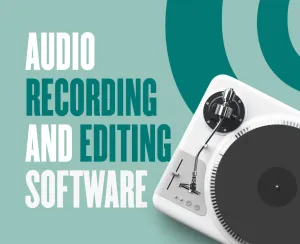If you're a podcaster who often records interviews with guests remotely, you know the frustration of dealing with muffled recordings. Podcasters have no control over WiFi connection quality, which can result in a subpar recording. Thankfully, one life-saving solution allows podcasters to record remotely with two interconnected devices. Have you ever heard of double-ender recordings? If not, let's delve into the secrets behind creating podcasts with the exquisite sound quality!
Main Terminology Explained
First things first! What do we mean by double-ender recording? It's a widely-used term in audio production that refers to recording two people in different locations at the same time. The idea is to have two separate audio tracks recorded simultaneously. This results in a higher quality sound, as each person records their audio through their device.
In order to set up a double-ender recording, both parties need to be in communication with each other through a video call. The host records their audio on their end while the guest does the same with their own equipment. The beauty of double-ender recording is that each person records in their optimal recording environment. The post-production process involves merging the two recordings into a single cohesive track to produce a high-quality interview.
Double Ender Podcast Recording Benefits
When it comes to double-ender podcast recording, the benefits outweigh the disadvantages. Here are a few that will make you want to start recording with two devices right away:
#1 Record in a Cozy Environment
One of the obvious benefits of double-ender recording is working in a familiar and optimal environment. Hosts stop worrying about the noise coming from their dog or the kids playing in the other room. So do guests, who can also record high-quality sound from the comfort of their homes.
#2 Additional Backup
In some cases, the guest might not be available at the desired time. Double-ender recording offers extra security in case something unexpected comes up. Podcast hosts can always ask their guests to record their part and send it later. On the other hand, if the guest cannot make the recording, there is always the host's backup audio.
There are many more reasons why double-ender recording is becoming increasingly popular in podcasting. The list of benefits goes on, but we'll leave some for you to discover!
Stage Setup: Double Ender Recording Software
Setting up a double-ender recording is simple and easy. In fact, you might already have all the equipment necessary to start recording remotely with two devices. The only investment you may need is double-ender recording software. Let's take a look at some suitable options on the market!
Choose The Leader! AI-Powered Podcast Editing Software
A computer with double-ender recording software and an external microphone are the two essential components for newbies. The goal is to have the minimum of gear to get up and running asap. When it comes to double-ender recording software, we recommend options that provide free trial periods.
Opt for Podcastle, powerful AI-assisted podcast recording and editing software with cutting-edge tools and features. The software is very intuitive and easy to use. You can start recording high-quality podcasts within minutes! It's a one-stop solution that will save you precious time, energy, and money.
Podcastle offers a free trial to explore all the features before committing to a paid plan. You can always upgrade later on as your podcast grows and develops. It's a user-friendly program suitable for both beginners and experts looking for powerful double-ender recording software.
Podcastle's main features include:
- Automatic noise removal and silence removal: The software uses AI to identify and remove background noise from audio as well as silences. It's a huge timesaver, as you don't need to go through the recording manually to make the edits.
- Automatic leveling: Another feature is automatic volume equalization between host and guest. If the final result doesn't meetyour expectations, you can always adjust volume levels manually. Podcastle will do the heavy lifting for you, letting you focus on other essential tasks.
- Double-ender recording: The feature allows podcasters to simultaneously record both sides of the conversation. Hosts can even add additional tracks while editing the final draft. Why put a technical and logistic burden on guest speakers when they can attend the session from the comfort of their homes?
- AI transcription: After the recording is finished, you can use the software to transcribe your podcast automatically. The text transcriptions are very accurate and can be edited later if needed.
Podcastle comes with tools enabling endless opportunities for creators. Explore the software and discover all the benefits relevant to your podcasting needs!
Getting Started with Double-Ender Recording
Start by testing the waters with a short recording. Experiment with different tools and see what works best for you. Also, take your time to get familiar with the software. Once you feel comfortable, you can start recording longer episodes.
Here are a few valuable tips for anyone interested in using double-ender podcasts in their content production:
- Use high-quality headphones to avoid sound issues.
- Make sure there are no background distractions like television, radio, or people talking. Record in a quiet environment to get the best sound quality.
- Think of easy-to-implement markers to denote the beginning and end of each question. It will save you time in the editing process. Ensure your guest is aware of the signal so they can be prepared. Markers can include a clap or a code word.
What Next?
A poor WiFi connection can ruin your podcast recordings, wasting time and causing frustration. By following the steps described in this article, you can have peace of mind knowing that no matter what happens, you will be able to save your recording and produce a high-quality podcast episode.










